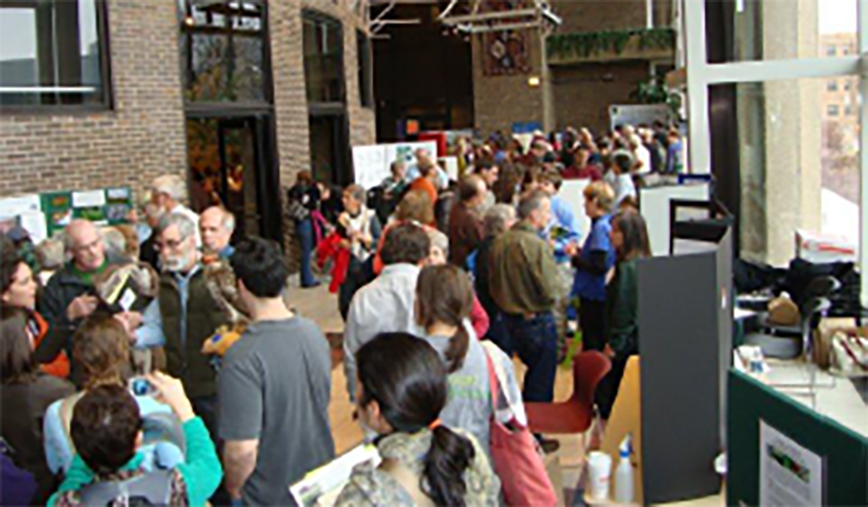Pam’s Perspective
From the…
Pam Otto is the Manager of Natural Programs and Interpretive Services for the St. Charles Park District
February 8, 2013
Hands down, the outdoors is the best place to learn about nature and things wild. But sometimes, time spent indoors can be enlightening too.
Last Saturday was Wild Things, an all-indoor biennial conference described in promotional materials as “organized by Audubon Chicago Region in cooperation with the Habitat Project, the Volunteer Stewardship Network, and Chicago Wilderness through funding from the USDA Forest Service and US Fish & Wildlife Service.”
Which is a fancy way of saying that Nature Nerds and EcoGeeks came from miles around to renew old friendships, meet new ones, network, bond, commiserate and learn, all within the mostly friendly confines of the University of Illinois-Chicago’s Student Center East. (The only reason for the qualifier “mostly” had nothing to do with the conference or the people attending, but rather a cranky and mostly unhelpful worker at the center’s Dunkin’ Donuts mini-shop. Turns out I didn’t need his coffee anyway, as the Wild Things organizers thoughtfully provided free Starbucks to all attendees. .)
The day began at 9 a.m. with concurrent keynote addresses on the importance of stitching together our greenspace and natural areas, along with a fascinating description of how wildlife is evolving around us. The 1,100-plus registrants were then turned loose to sit in on any of 89 30- and 45-minute breakout sessions, spaced throughout the day and interspersed with visits to the Wild Things exhibit hall and an extra-long lunch hour with book signings, poster sessions and more.
The result was an event filled with hour after hour of Gee Whiz! and Who Knew?! Moments, some encouraging, some a tad disheartening, and all
Here’s a sampling of the sort of prime knowledge nuggets the St. Charles Park District attendees took back to our home base at Hickory Knolls:
. Researchers at Midewin National Tallgrass Prairie are giving birding a run for its money. They have produced a gorgeous four-color publication, “Spider Watching at Midewin,” that details the habits and life cycles of a dozen different spider families that live within the 19,000-acre preserve—as well as most of northeastern Illinois. My favorite fact there? Male spiders use many strategies to woo their mates, including drumming, web strumming and silken nuptial gifts, and every single one of them are designed to persuade and pacify the female. (Nice work, lady spiders!)
Check out the 30-page Spider Watching brochure at www.fs.usda.gov/midewin
. As if White Nose Syndrome wasn’t enough to contend with, North American bats who survive this devastating fungal disease now have to contend with Immune Reconstitution Inflammatory Syndrome—an equally injurious condition whereby the bats’ own immune systems slip into overdrive, attacking not only the fungus but also the bats’ wing tissue, making it difficult if not impossible to fly.
Also, for those who keep track of such things, the common name of the eastern pipistrelle bat (Perimyotis subflavus) has been changed to a somewhat more descriptive tri-colored bat. (The species’ fur is black at the base, followed by a band of lighter brown, and dark at the tips.)
. Singing insects, that group of songsters consisting primarily of crickets, grasshoppers and cicadas, are expanding their ranges. Naturalist Carl Strang of the Forest Preserve District of DuPage County presented overviews of some eight different species of singing insects that can now be found well beyond what was considered their “natural” range. Although it would be easy to ascribe these shifts to climate change, Strang pointed out that there may well be other factors at work. He noted that one insect, the broad-winged tree cricket, Oecanthus latipennis, is expanding its range southward as well as north.
I was excited to learn that insects with what could be the best bug names ever, the slightly musical conehead (Neoconocephalus exiliscanorus) and the handsome trig (Phyllopalpus pulchellus) are slowly heading in our direction. Though not yet present in Kane County, they are now in northern Indiana, an easy road trip away.
If this is the sort of information you find endlessly fascinating, get out your calendar and start x-ing off the days between now and 2015, when Wild Things will return. And to fill in the void, pick a day—pick many days!—to visit our area’s outstanding natural areas with your own favorite Wild Thing.
Pam Otto is the manager of nature programs and interpretive services for the St. Charles Park District. She can be reached at 630-513-4346 or potto@stcparks.org.

